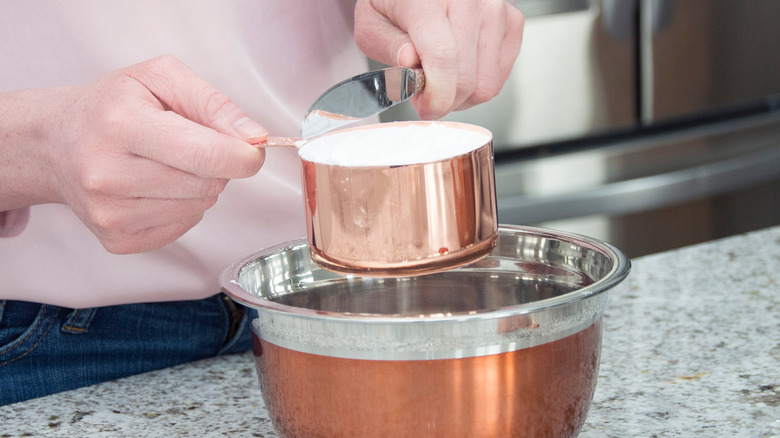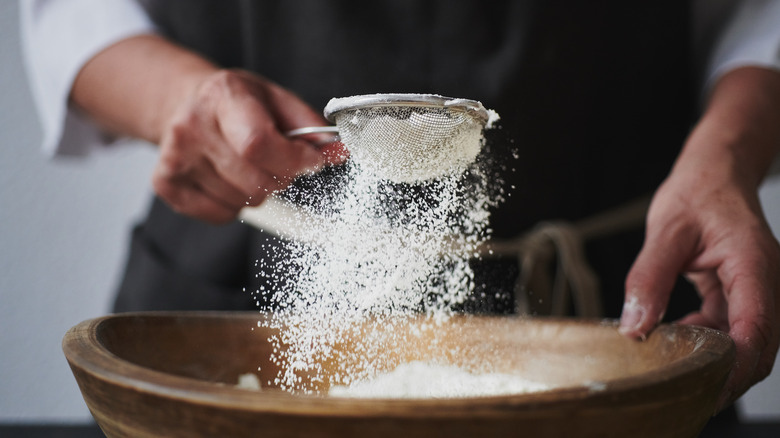Why Ina Garten Always Skips Weighing Ingredients
When baking, weighing your ingredients, especially flour, is the most accurate way to measure. We can't stress that enough. Investing in a food scale — even a standard $10 one — not only saves time with cleanup but is also a quicker way to measure, making it well worth the price of a fancy latte.
One of Ina Garten's favorite kitchen tools is her OXO kitchen scale, and many of her recipes are written with precise measurements, down to how much salt to add, which is commonly written as "to taste" by other chefs. However, curiously, her baking recipes aren't written with weight measurements. When asked why by a fan, Garten responded in the Q&A section of her website, writing, "Weighing ingredients is the most precise way to measure, but because I know many people do not have kitchen scales, I always use measuring cups to make sure the recipe works without a kitchen scale."
Garten's recipes are tested up to 12 times by multiple assistants, including home cooks. Garten takes notes, amending the recipes so they're foolproof by publication, which can take years, like her Boston creme pie recipe. With a less accurate method of measuring, it's more critical for home cooks to use the correct technique so they don't end up with tough baked goods.
How Ina Garten measures ingredients for recipes
Most baking recipes include some type of flour, which adds structure to baked goods. Without a scale, measuring this ingredient by volume often leads to adding too much, resulting in a tougher, drier baked good. Since the flour becomes dense and compact when stored, an additional step is required to measure it accurately.
Although sugar can be measured this way, the commonly used "scoop and level" method can deliver 33% more flour by volume, making it an inconsistent way to measure for baking, which depends on accuracy. The greater the amount of flour needed in a recipe, the higher the discrepancy.
When Ina Garten writes her recipes that include flour, she avoids the commonly used "scoop and level" method, adding a step. She uses a spoon to aerate the flour in the canister, then sprinkles it into the appropriate dry measuring cup. Garten overfills the cup, then levels it with a straight edge, removing the excess. If you had a scale to check, one cup of flour should equal 120 grams, or 4.25 ounces. The "scoop and level" method can produce as much as 160 grams without first aerating the flour. Garten finds that spooning the flour delivers a more standardized amount, making sifting unnecessary for this purpose.
To sift or not to sift
Many bakers have transitioned away from sifting all dry ingredients. Traditionally, bugs and seeds were unintentionally packaged with flour, making sifting a necessary step, but thankfully, manufacturers have now taken care of that. However, some ingredients like cocoa powder and powdered sugar tend to clump, and should still be sifted to make a smooth batter, icing, or dough.
While Ina Garten does not sift before she measures, she does sift flour when combining it with other dry ingredients to distribute them evenly. This prevents having pockets of bitter-tasting baking soda and overworking the flour, which activates the gluten and makes the fresh baked goods tougher.
Recipes that still call for sifting will have "sifted" listed before or after the ingredient. There is an important distinction. If the recipe is written as "two cups sifted flour," the flour should be sifted before measuring it by volume. However, this wouldn't matter if you were using a scale. When the recipe states, "two cups flour, sifted," whether you are weighing or using Garten's method, the flour should be sifted after it's been measured.



